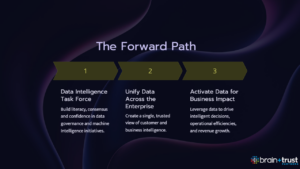“Website traffic is down.” It’s a refrain we’ve heard over and over again in recent months — and, while it’s widely true of any business or financial institution, it’s a refrain that’s become particularly common among new car dealers.
That’s understandable, isn’t it? After all, the chip shortages are over, inventory is getting back to pre-pandemic levels, the interest rates are higher than they’ve been in a generation, highly publicized federal EV rebates are scheduled to begin in January, and average new car transaction prices are still at near record highs. After two or three years of dealers being able to name their prices, it seems there are plenty of dealers ready to throw up their hands and say, “It was fun while it lasted …” especially as the GA4 numbers roll in and report fewer and fewer visitors to their websites.
But what if we told you that the number of visitors to your site hasn’t gone down? Or, at least, hasn’t gone down nearly as much as you thought? What if we told you that the conversion metrics your marketers are showing you — especially those sky-high conversion rates — are all wrong?
Extraordinary claims require extraordinary evidence, right? Let’s go.
GA is Not Reporting Accurate Traffic Numbers
![]()
Read that again. Without cookies, Google Analytics would view every “hit” as its own visit, and each of those visits would be a bounce. This data would be useless. As a result, GA makes the logical choice to just not track those people (emphasis ours).
After verifying the experiment on our end, we showed the thread to some colleagues. The most conservative, GA-defending response was, “If cookies are disabled or not present, GA may still track visits, but it might struggle to differentiate between different users and sessions. In such cases, GA may not be able to accurately measure metrics like unique users, session duration, and user engagement.”
Which — yeah! That’s the problem, exactly!
Who Disables Their Cookies?
In the recent past, cookies were only ever disabled by — well, geeks. Internet-savvy consumers with valid privacy concerns, corporate trust issues, and a desire to breeze through the internet without being constantly bombarded with ads were among the first people to popularize cookie-free browsing, but they were a minority.
That all changed in 2021, when Apple began making privacy a cornerstone of their iPhone advertising campaigns.
iPhone Privacy Ads Drive the Point Home
Apple launched iOS 14 with the company’s then-new App Tracking Transparency (ATT) feature front and center in its marketing campaigns. ATT required apps to ask the user’s permission before tracking their data across other apps or websites owned by other companies, enhancing user privacy and giving individuals more control over how their data is used by apps and websites.
Even then, most people initially just clicked “Allow,” “OK,” or whatever option got them to the content they were trying to consume in the least amount of time. But as we saw after the implementation of the General Data Protection Regulation (GDPR) in the European Union in 2018, after realizing that they could get their content without being tracked, most people — nerds and normals, alike — opted out of tracking.
And, by most people, we mean: more than 96% of everyone who was given the option.
The change met fierce resistance from companies like Facebook, whose market advantages and revenue streams are built on leveraging users’ data to target the most effective ads at those users. Facebook went so far as to take out full-page newspaper ads claiming that the change would not just hurt Facebook but would destroy small businesses around the world.
Less than a month after iOS 14 launched with ATT, Ars Technica announced that the opt-out rates for iOS users “exceeds advertisers’ worst fears” and cost advertisers like Facebook more than $10 billion in revenue.
And that was just 2021! Since then, Apple has gone from strength to strength, hitting a new record in Q4 2023 and selling more than 350 million new iPhones — and updating countless others — to run with ATT. As more and more people buy iPhones or simply upgrade to newer versions of the venerable Apple smartphone, the number of people “opting out” of being tracked only grows.
So, who disables their cookies? Everyone.
Next Year, Customers Will Be More Invisible Than Ever

This might be a tough pill for Android enthusiasts (and we are them) to swallow, but in North America, at least: as Apple goes, so does the smartphone market.
That means that, as Apple has increased its marketing to emphasize consumer protections and data privacy, Android parent company Alphabet (Google) found its hand forced. And, in 2022, the company announced plans to roll out, “a multi-year initiative to build the Privacy Sandbox on Android, with the goal of introducing new, more private advertising solutions. Specifically, these solutions will limit sharing of user data with third parties and operate without cross-app identifiers, including advertising ID. We’re also exploring technologies that reduce the potential for covert data collection, including safer ways for apps to integrate with advertising SDKs.”
Android Privacy Sandbox Roadmap

The Privacy Sandbox is still in Beta (see roadmap, above), but it’s coming … and, even without it, privacy-first browsers like Brave, DuckDuckGo, and others are gaining popularity, even as more and more people using mainstream browsers like Chrome and Safari are simply selecting “do not allow.”
So what if Google is deprecating 3rd-party cookies? Everyone is blocking them, anyway, so it doesn’t matter.
At the same time, Meta (Facebook) has deprecated its pixel — another cornerstone of online advertising and metrics — and walled-off its digital garden in a bid to “safeguard” its users’ privacy.
What, then, is a good digital marketer to do?
For starters, digital marketers of any kind — and especially car dealers — need to break free from their addiction to third-party data and start mining the extraordinary amounts of customer data that they already have.
This is Why Everyone is Talking About CDPs
No data is clean, but most is useful.
– Dean Abbott, Co-founder and Chief Data Scientist at SmarterHQ
Cookies are disabled, pixels are deprecated, Universal Analytics is gone, and traditional tracking methods and metrics have lost their effectiveness. Surviving and thriving in this new reality necessitates a strategic shift towards mining first-party data and encouraging consumers to engage directly with a brand. This first-party data — existing data about existing customers gained from the source — is a long-overlooked goldmine providing a more reliable foundation for personalized marketing strategies … and this is where the CDP comes into play.
In the absence of cookies, a CDP acting as a centralized hub that aggregates and unifies customer data from diverse sources becomes the go-to tool for marketers, offering a comprehensive, 360-degree view of their customer and providing a holistic understanding that empowers brands to tailor their marketing approach with precision, ensuring a more personalized and targeted strategy and, crucially, eliminating duplicate and pointless ad spending.
That 360-degree view includes social media, direct interaction, phone and location data, and more — and the best CDPs will ingest all that data in a schemaless way, saving countless IT and support hours “cleaning up” disparate data feeds. What’s more, the best CDPs will do this in real time, enabling the kind of “best in class” experiences modern consumers expect from every brand interaction.
Leveraging social media and other non-traditional data channels in this way not only fosters engagement, but encourages more human connections with users who are incentivized to follow, interact, and share their preferences with your brand, providing valuable insights and training lookalike audiences and digital twins to help develop and perfect targeted, individualized outreach to audiences with similar characteristics, broadening your scope of potential customers.
In essence, as data experts, our mission is to guide marketers through this evolving landscape. By championing the use of CDPs and emphasizing the importance of direct engagement and strategic social media utilization, we equip businesses to thrive in a post-cookie world.
ORIGINAL CONTENT FROM BRAIN+TRUST.
ADDITIONAL NOTES AND SOURCES:
- We talk a bit about how even the biggest legacy brands can be caught out by changing times in this episode of the Say-It-Again podcast.
- We talk about a “schemaless” CDP and how the ability to ingest and use data without the need for pre-formatting can save countless technical support hours. You can learn more about schemaless database management here.







